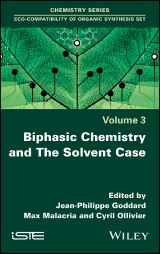Details

Biphasic Chemistry and The Solvent Case
1. Aufl.
|
139,99 € |
|
| Verlag: | Wiley |
| Format: | |
| Veröffentl.: | 20.04.2020 |
| ISBN/EAN: | 9781119694908 |
| Sprache: | englisch |
| Anzahl Seiten: | 240 |
DRM-geschütztes eBook, Sie benötigen z.B. Adobe Digital Editions und eine Adobe ID zum Lesen.
Beschreibungen
<P>Biphasic Chemistry and The Solvent Case examines recent improvements in reaction conditions, in order to affirm the role of chemistry in the sustainable field.<P> <p>This book shows that those who work within the chemistry industry support limits for the use of toxic or flammable solvents, since it reduces the purifications to simple filtrations. Thanks to commercial scavengers, solid phase syntheses are now available to all. Fluorine biphasic catalysis enables extremely efficient catalyst recycling and has a high applicability potential at the industrial level.<P> <P>This book also reviews the many studies that have shown that water is a solvent of choice for most synthetic reactions. Particular traits can be obtained and the effects on thermodynamics make it possible to operate at lower temperatures, thereby achieving energy savings. Finally the great diversity of application of the reactions without solvents is illustrated.<P>
<p><b>Chapter 1. Solid-phase Supported Chemistry</b><b> 1<br /></b><i>Géraldine GOUHIER</i></p> <p>1.1. Introduction 1</p> <p>1.2. Principle of solid-phase chemistry 2</p> <p>1.3. Advantages 4</p> <p>1.4. Safety and environment 4</p> <p>1.5. Disadvantages and limitations 5</p> <p>1.6. Evolution 6</p> <p>1.7. Supports: linear skeletons 6</p> <p>1.8. Three-dimensional resins 7</p> <p>1.8.1. Macroporous resins 7</p> <p>1.8.2. Gel resins 8</p> <p>1.9. Characteristics of gel supports 10</p> <p>1.9.1. Functionalization rate 10</p> <p>1.9.2. Swelling properties 10</p> <p>1.9.3. Size of the beads 12</p> <p>1.9.4. Influence of cross-linking on swelling 12</p> <p>1.9.5. Diffusion effect 13</p> <p>1.9.6. Influence of cross-linking on diffusion 13</p> <p>1.9.7. Influence of steric bulk 14</p> <p>1.9.8. Influence of agitation 14</p> <p>1.9.9. Proximity and pseudodilution effects 14</p> <p>1.9.10. Proximity effect 15</p> <p>1.9.11. Pseudodilution effect 15</p> <p>1.9.12. Availability and costs 16</p> <p>1.10. Functionalization of the solid support 17</p> <p>1.10.1. Spacer arms 17</p> <p>1.10.2. Linkers 18</p> <p>1.10.3. Influence of functionalization 19</p> <p>1.11. Analytical methods and reaction monitoring 20</p> <p>1.11.1. Centesimal analyses 20</p> <p>1.11.2. Colorimetric dosages 22</p> <p>1.11.3. Indirect analyses 23</p> <p>1.11.4. Infrared spectroscopy 23</p> <p>1.11.5. Nuclear magnetic resonance spectrometry 24</p> <p>1.11.6. Mass spectrometry 29</p> <p>1.12. Solid-phase syntheses 29</p> <p>1.12.1. Supported reagents 29</p> <p>1.12.2. Supported chiral catalysts 32</p> <p>1.12.3. Scavengers 34</p> <p>1.13. Innovative applications and processes 35</p> <p>1.13.1. Examples 35</p> <p>1.13.2. Parallel syntheses on a solid support 37</p> <p>1.14. Activation on solid phase 40</p> <p>1.14.1. Microwave reactions 40</p> <p>1.14.2. Reactions under high pressure 42</p> <p>1.14.3. Reactions under ultrasound 42</p> <p>1.14.4. Supported electrochemical reactions 43</p> <p>1.14.5. Reactions in ionic liquid 43</p> <p>1.15. Industrial applications and prospects 45</p> <p>1.16. Conclusion 45</p> <p>1.17. References 45</p> <p><b>Chapter 2. Fluorous Tags and Phases for Synthesis and Catalysis</b><b> 57<br /></b><i>Jean-Marc VINCENT</i></p> <p>2.1. Introduction 57</p> <p>2.2. Structures and properties of fluorous tags and phases 58</p> <p>2.2.1. History of fluorous chemistry 58</p> <p>2.2.2. Fluorous tags 59</p> <p>2.2.3. Fluorous solvents 60</p> <p>2.2.4. Solid fluorous phases 62</p> <p>2.3. Separation/recycling methodologies using fluorous tags and phases 64</p> <p>2.3.1. Application for catalysis 64</p> <p>2.3.2. Application for synthesis 75</p> <p>2.4. Conclusion 90</p> <p>2.5. References 90</p> <p><b>Chapter 3. Chemistry In and On Water</b><b> 99<br /></b><i>Marie-Christine SCHERRMANN</i></p> <p>3.1. Introduction 99</p> <p>3.1.1. Presentation and history 99</p> <p>3.1.2. Position in the context of green chemistry 100</p> <p>3.2. General: origin of reactivity in and on water 100</p> <p>3.2.1. Water structure and properties 100</p> <p>3.2.2. Chemistry in water: the hydrophobic effect 102</p> <p>3.2.3. Origin of reactivity on water 106</p> <p>3.3. Limitations of the method 107</p> <p>3.4. Reactivity in and on water 107</p> <p>3.4.1. Pericyclic reactions 107</p> <p>3.4.2. Addition reactions of carbonyl derivatives 121</p> <p>3.4.3. Coupling reactions catalyzed by transition metals 127</p> <p>3.4.4. Radical reactions 135</p> <p>3.4.5. Oxidation and reduction reactions 136</p> <p>3.5. Multistep syntheses 142</p> <p>3.6. Industrial applications 143</p> <p>3.7. Conclusion 144</p> <p>3.8. References 145</p> <p><b>Chapter 4. Solvent-free Chemistry</b> <b>169<br /></b><i>Thomas-Xavier MÉTRO, Xavier BANTREIL, Jean MARTINEZ and Frédéric LAMATY</i></p> <p>4.1. Introduction 169</p> <p>4.2. General information on solvent-free synthesis: why use a solvent? 170</p> <p>4.3. Working without solvents 170</p> <p>4.4. Limitations of the technique 171</p> <p>4.5. In practice: methods and reactivity 172</p> <p>4.5.1. Methods and equipment. 172</p> <p>4.5.2. Examples 172</p> <p>4.5.3. Scaling up: industrial applications 173</p> <p>4.6. Mortar and pestle 176</p> <p>4.6.1. Methods and equipment 176</p> <p>4.6.2. Examples 176</p> <p>4.6.3. Scaling up: industrial applications 177</p> <p>4.7. Ball-mills 178</p> <p>4.7.1. Methods and equipment 178</p> <p>4.7.2. Examples 180</p> <p>4.7.3. Scaling up: industrial applications 185</p> <p>4.8. Extruders 190</p> <p>4.8.1. Methods and equipment 190</p> <p>4.8.2. Examples 191</p> <p>4.9. Microwave irradiation 192</p> <p>4.9.1. Methods and equipment 192</p> <p>4.9.2. Examples 194</p> <p>4.9.3. Scaling up: industrial applications 196</p> <p>4.10. Photochemistry 198</p> <p>4.10.1. Methods and equipment 198</p> <p>4.10.2. Examples 199</p> <p>4.10.3. Scaling up: industrial applications 201</p> <p>4.11. Comparison of techniques 204</p> <p>4.12. Conclusion 206</p> <p>4.13. References 206</p> <p>List of Authors 217</p> <p>Index 219</p>
<P>Jean-Philippe Goddard is Professor of Molecular Chemistry at the University of Upper Alsace, France, and Deputy Director of LIMA (Laboratory of Molecular Innovation and Applications), Strasbourg, France.<P> <P>Max Malacria is Emeritus Professor at Sorbonne University, Paris, France, where his research deals with catalysis, radical chemistry and aromaticity.<P> <P>Cyril Ollivier is a CNRS Research Director at the IPCM (Parisian Institute of Molecular Chemistry) at Sorbonne University.<P>


















